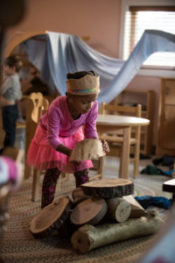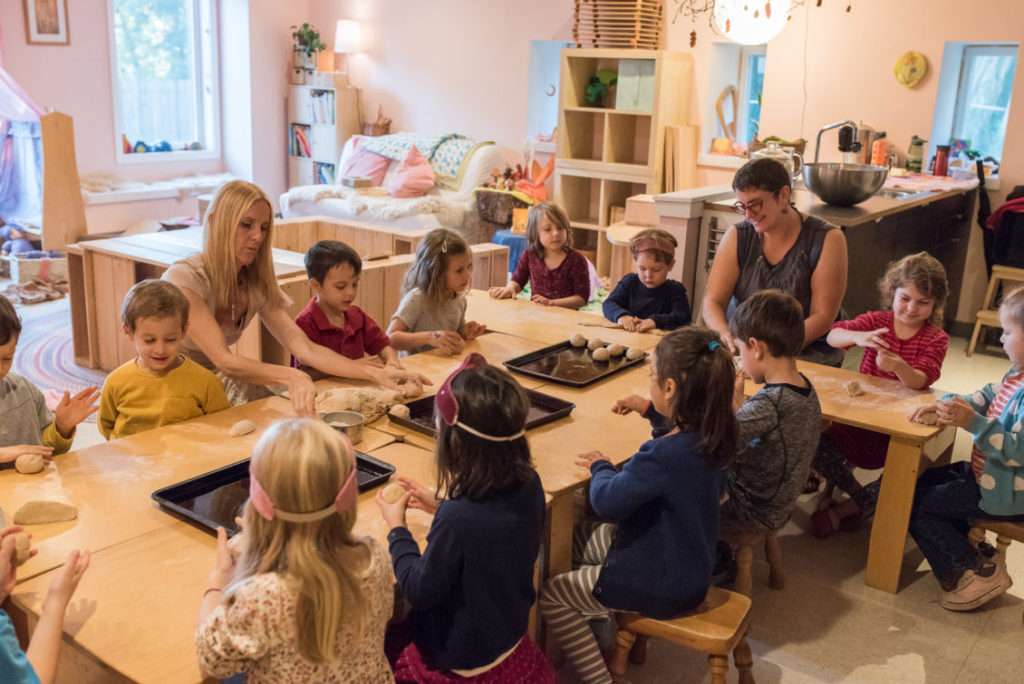Waldorf News
Four Unique Aspects of a Waldorf Kindergarten

By phillywaldorf, Waldorf School of Philadelphia
Why does it feel so different, so special, in a Waldorf Kindergarten? There is a peaceful quiet under the hum of activity and focus, the teachers speak and sing softly and the children move about the room with a comfortable confidence at any given moment.
There are many things that contribute to this unique setting, including the natural classroom design, the smell of fresh bread or soup, or the way the teachers move about the room doing purposeful work.
There is also a deeper level of social, emotional and academic learning in the Waldorf Kindergarten that is a pervasive undercurrent in the daily rhythm of our early childhood classrooms.

Labeled as “undercurrent” only because the children would never come home to report on what was “learned,” as this age-appropriate atmosphere focuses on play-based learning and teacher modeling. Children would instead tell tales of imaginative games, a puppet show story, time outside, or proudly report that they had helped make bread or sweep the floor.
Here are four unique aspects that make up a Waldorf Kindergarten and differentiate it from some of its more main-stream counterparts in early childhood education:
Play Based Learning
 Learning in Waldorf early childhood is developmentally appropriate for children age 3-6. What is best for learning at this age is self-directed play. Many early education experts are recommending a swift return to developmentally appropriate, play-based learning in early childhood.
Learning in Waldorf early childhood is developmentally appropriate for children age 3-6. What is best for learning at this age is self-directed play. Many early education experts are recommending a swift return to developmentally appropriate, play-based learning in early childhood.
This New Zealand study, covered by The Telegraph, reports that “Pupils kept out of formal schooling until the age of seven perform just as well those subjected to normal lessons at five… In some assessments of reading skills, those with a later start actually overtook their peers by the age of 10.”
The Harvard Education Letter concurs, calling the early childhood trend of, “scripted curricula and reduced recess” a matter of “serious concern.” The researchers ask specifically, “Have kids gotten smarter? Can they learn things sooner? What effect has modern culture had on child development? The surprising answers—no, no, and none.
”The reality is, children learn all kinds of imperative skills through play. Self-directed play promotes neural pathway development, hones social skills and peer navigation, advances large and small motor skills and strengthens motor planning and coordination.
This does not mean, however, that teachers only facilitate a play environment. The children think their day is filled with play, but teachers are focused on the children’s developing skills, discussed next.
“Research shows greater gains from play-based programs than from preschools and kindergartens with a more academic focus” – The Washington Post, January 2015
Pre-Academic Experiential Foundations
 Through creative play, story time, artistic activities and outdoor exploration, the children actually work on language development, basic math, working with peers, listening skills, lengthening attention span and developing memory.
Through creative play, story time, artistic activities and outdoor exploration, the children actually work on language development, basic math, working with peers, listening skills, lengthening attention span and developing memory.
For example, during creative play time, as children play and imagine with a wide variety of natural toys and materials, they are developing their imagination, interacting with peers, problem-solving, and carrying tasks to completion.
As they sit quietly in a circle for story time, morning verse or a puppet show, they are learning to recite and remember, listen for sustained periods of time, expand their vocabulary and understand the sounds and meanings of language.
Storytime in a Kindergarten classroom is especially important in the Waldorf approach to teaching reading, which develops a child’s comprehension skills before phonic skills.
Listening, comprehending and imagining what is said in spoken word is key to future reading comprehension when words on a page must go beyond the stale script and develop into a richness in their minds.
Waldorf early childhood students spend time with many different artistic activities as well including beeswax modeling, crayon drawings, sewing, and finger knitting. These activities develop small motor skills, the ability to focus on a task for a lengthened time and finger knitting encourages math basics such as counting and understanding interlacing patterns.
Even snack time is learning time. This group activity teaches social interaction, direction following and is an introduction to some of the science and math basics involved within cooking.
Sensory Integration

Waldorf strives to educate the whole child, and that includes the senses and their relation to the body and movement. Now called “sensory integration,” experts are beginning to understand why the ability to effectively process and organize sensations is essential to learning, especially through visual and auditory processing.
The Waldorf Kindergarten cultivates a deepened awareness of the senses and works towards deepening essential sensory development in young children.
First and foremost, early childhood students in Waldorf schools are encouraged to move and then move some more. Recess, at least three times daily and almost always outdoors, includes nature walks, teeter totter building, log jumping, tree climbing and running along with other activities.
Getting messy to develop tactile senses is also encouraged through sand play, mud play, recess in rain, snow, wind and sunshine. Tactile skills are used indoors in cooking, dough kneading, beeswax sculpting and other arts activities.
Music and dance are also regularly seen in Waldorf Kindergartens. Teachers are often singing, moving and encouraging children to do the same. And while taste might not seem like a sense that could be cultivated, Waldorf Kindergartens are unique in that each day of the week represents a different, handmade healthy snack for the children full of rich and (often new) textures, smells and tastes for young ones.
And all these activities, which at their heart are natural child’s play, are encouraged instead of discouraged in Waldorf early childhood education. Children are never told to stop rolling in the grass, climbing trees, stomping in mud or picking up mulch and stones as these activities are essential to developing sensory integration. We understand that a large variety of sensory activities are key in building mobility, motor skills, flexibility, spatial awareness, tactile sense, proprioceptive senses, and all sensory integration.
Nature-Based Learning
 While we have already discussed the sensory richness of outdoor play, time in nature has other amazing brain benefits as well, including boosted cognitive performance, reduced anxiety, improved test scores and much more.
While we have already discussed the sensory richness of outdoor play, time in nature has other amazing brain benefits as well, including boosted cognitive performance, reduced anxiety, improved test scores and much more.
This is why Waldorf children in early childhood play outside, in natural vs. playground settings, in all weather and all seasons.
Children who immerse themselves in a natural and ever-changing environment simply have more opportunities to learn new things in new ways. Being outdoors provides expanded opportunity for physical exploration. Inspiration is everywhere in the change of seasons and cycles of life, and children develop a bond with nature as they begin to understand their place within it. Also, a hearty dose of curiosity and respect for nature also develops, laying a foundation for future scientific investigation.
As Richard Louv, author of “Last Child in the Woods,” says, “Time in nature is not leisure time; it’s an essential investment in our children’s health.”
From the Waldorf School of Philadelphia blog, Loving Learning
 Bay Area Teacher Training
Bay Area Teacher Training ~ Ensoul Your World With Color ~
~ Ensoul Your World With Color ~ Space speaks. Its language is movement.
Space speaks. Its language is movement. Association for a Healing Education
Association for a Healing Education The Journey is Everything
The Journey is Everything Train to Teach in Seattle
Train to Teach in Seattle Waldorf EC Training & Intensives in Canada
Waldorf EC Training & Intensives in Canada Immersive Academics and Arts
Immersive Academics and Arts Bringing Love to Learning for a Lifetime
Bringing Love to Learning for a Lifetime The Art of Administration and Leadership
The Art of Administration and Leadership Caring for All Stages of Life
Caring for All Stages of Life Jamie York Books, Resources, Workshops
Jamie York Books, Resources, Workshops Everything a Teacher Needs
Everything a Teacher Needs Roadmap to Literacy Books & Courses
Roadmap to Literacy Books & Courses Summer Programs - Culminating Class Trips
Summer Programs - Culminating Class Trips Dancing for All Ages
Dancing for All Ages Quality Education in the Heartland
Quality Education in the Heartland Waldorf-inspired Homeschool Curriculum
Waldorf-inspired Homeschool Curriculum Art of Teaching Summer Courses 2025
Art of Teaching Summer Courses 2025 Discovering the Wisdom of Childhood
Discovering the Wisdom of Childhood Middle School Science With Roberto Trostli
Middle School Science With Roberto Trostli Flexible preparation for your new grade
Flexible preparation for your new grade Grade Level Training in Southern California
Grade Level Training in Southern California Apply Today: New Cohort Starts Nov. 2025
Apply Today: New Cohort Starts Nov. 2025 Storytelling Skills for Teachers
Storytelling Skills for Teachers Full-Time Teacher Education
Full-Time Teacher Education Transforming Voices Worldwide
Transforming Voices Worldwide RSS Feeds
RSS Feeds